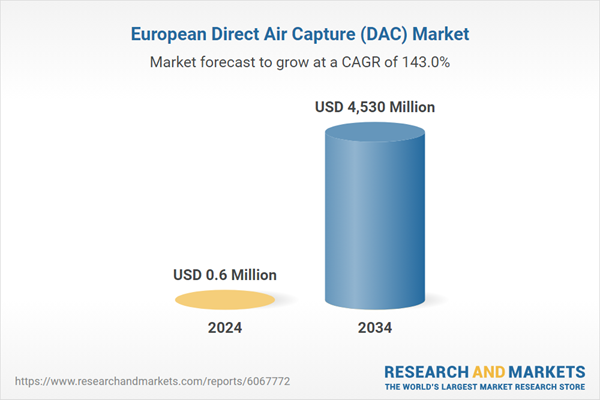This report comes with 10% free customization, enabling you to add data that meets your specific business needs.
Regional obstacles that the market must overcome include high setup and operation costs, energy-intensive CO₂ capture, and a lack of infrastructure for the storage and use of carbon. Nevertheless, these obstacles are being addressed by greater EU funding, the integration of renewable energy, and growing participation from significant European industry players.
DAC is becoming a crucial component of Europe's decarbonisation strategy as technology advances and costs come down, allowing businesses to offset emissions and support a circular carbon economy.
Market Introduction
The market for direct air capture (DAC) in Europe is becoming a vital part of the region's plan to combat climate change and meet aggressive net-zero emissions goals. By actively absorbing carbon from the surrounding air, DAC technology presents a viable way to lower atmospheric CO₂ and support a circular carbon economy. Investment in DAC systems has increased as a result of Europe's strict environmental regulations, strong legal frameworks, and large government investments in the development of clean technologies.Technological advancements, particularly in efficient solid sorbents and liquid solvents, are driving significant improvements in the performance and scalability of DAC solutions. As renewable energy integration becomes increasingly prevalent, the energy-intensive nature of DAC processes is being mitigated, further enhancing viability. Major European companies and research institutions are actively exploring DAC applications, fostering innovation and collaboration across the sector.
Despite challenges such as high capital and operational costs, the growing demand for carbon removal solutions and increasing commitment to sustainability are expected to propel market growth. With the integration of DAC systems into broader carbon utilization strategies, the market offers vast opportunities for stakeholders to invest in eco-friendly technologies that support long-term decarbonization efforts in Europe.
Market Segmentation
Segmentation 1: by Application
- Carbon Capture and Storage
- Carbon Capture, Utilization, and Storage
Segmentation 2: by End User
- Chemicals and Fuels
- Carbon Mineralization
- Oil and Gas
- Others
Segmentation 3: by Technology
- Solid DAC
- Liquid DAC
Segmentation 4: by Country
- Iceland
- Norway
- U.K.
Market Trends, Drivers and Challenges of Europe Direct Air Capture Market
Ambitious climate goals and net-zero aspirations are driving the growth of the Europe Direct Air Capture (DAC) sector. Rapid developments in DAC technology, enhanced integration with carbon utilisation applications such as synthetic fuels, and rising governmental and private sector investments are some of the major trends. Increased funding for clean technology, favourable EU legislation, and rising CO2 levels are important motivators. High capital and operating expenses, a lack of infrastructure for storing CO₂, and the energy-intensive nature of DAC procedures are among of the market's obstacles, too. For broad adoption and long-term market viability in the area, these obstacles must be removed.How can this report add value to an organization?
Product/Innovation Strategy: This report provides a comprehensive product and innovation strategy for the Europe direct air capture market, highlighting opportunities for market entry, technological advancements, and sustainable practices. It offers actionable insights that enable organizations to meet carbon reduction goals and capitalize on the increasing demand for direct air capture across various sectors.Growth/Marketing Strategy: This report outlines a robust growth and marketing strategy specifically tailored for the Europe direct air capture market. It emphasizes a targeted approach to identifying niche market segments, establishing competitive advantages, and implementing innovative marketing initiatives to optimize market share and financial performance. By leveraging these strategic recommendations, organizations can strengthen their market presence, exploit emerging opportunities, and drive revenue growth effectively.
Competitive Strategy: This report formulates a strong competitive strategy designed for the Europe direct air capture market. It assesses key market players, suggests differentiation tactics, and provides guidance for maintaining a competitive edge. By following these strategic directives, companies can effectively position themselves against competitors, ensuring long-term success and profitability in a rapidly evolving market.
Key Market Players and Competition Synopsis
The companies that are profiled in the Europe direct air capture market have been selected based on input gathered from primary experts and analyzing company coverage, project portfolio, and market penetration.Some of the prominent names in this market are:
- Climeworks
- Soletair Power
- Avnos, Inc.
- Skytree
- Carbyon
This product will be delivered within 3-5 business days.
Table of Contents
Companies Mentioned
- Climeworks
- Soletair Power
- Avnos, Inc.
- Skytree
- Carbyon
Table Information
| Report Attribute | Details |
|---|---|
| No. of Pages | 75 |
| Published | April 2025 |
| Forecast Period | 2024 - 2034 |
| Estimated Market Value ( USD | $ 0.6 Million |
| Forecasted Market Value ( USD | $ 4530 Million |
| Compound Annual Growth Rate | 142.9% |
| Regions Covered | Europe |
| No. of Companies Mentioned | 5 |









